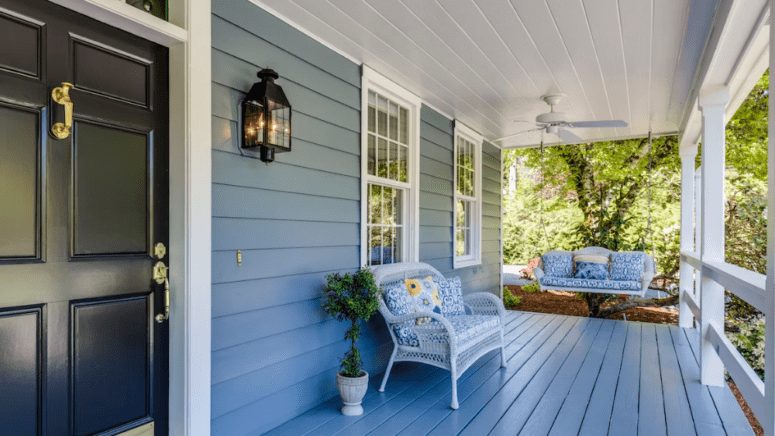How to Set Your Home’s List Price: 5 Factors That Matter Most
- Published on
- 15 min read
-
 Dena Landon, Contributing AuthorClose
Dena Landon, Contributing AuthorClose Dena Landon Contributing Author
Dena Landon Contributing AuthorDena Landon is a writer with over 10 years of experience and has had bylines appear in The Washington Post, Salon, Good Housekeeping and more. A homeowner and real estate investor herself, Dena's bought and sold four homes, worked in property management for other investors, and has written over 200 articles on real estate.
-
 Richard Haddad, Executive EditorClose
Richard Haddad, Executive EditorClose Richard Haddad Executive Editor
Richard Haddad Executive EditorRichard Haddad is the executive editor of HomeLight.com. He works with an experienced content team that oversees the company’s blog featuring in-depth articles about the home buying and selling process, homeownership news, home care and design tips, and related real estate trends. Previously, he served as an editor and content producer for World Company, Gannett, and Western News & Info, where he also served as news director and director of internet operations.
When you decide to sell your house, one of your first questions is likely “How much can I sell my house for?” If you’re like most home sellers, you probably plan on buying another home with the proceeds. Or, maybe you want to downsize and use the remaining cash for retirement. But you first must learn how to set a list price.
By and large, your list price is determined by your local current real estate market conditions — what people are willing to pay for a home like yours. It’s extremely important to get the list price right from the first day your home goes on the market.
“The most important factor of getting that list price right is to get the most visibility to the right buyers the first time around,” says Megan Toll, a top agent in Philadelphia, Pennsylvania, who works with his husband and business partner Kevin Toll, on 67% more single-family homes than the average area agent.
Pricing your home too low means leaving money on the table, but pricing too high can mean your home sits on the market. High days on market matters for a listing because it can make future buyers worry that something must be wrong with your house if it’s been sitting unsold for too long.
Buyers commonly narrow their search based on price parameters, and if you price outside their budget, they won’t even see your home until you’ve had to reduce the price to fall into their range, Megan Toll explains. By that point, they’ll know that it’s been sitting on the market and wonder if it has any flaws.
A good starting point to see what your home might be worth is with HomeLight’s Home Value Estimator. This online tool uses information from multiple sources to create a real-time home value estimate based on current market trends. While it can give you an initial idea of how your home’s value might have increased since you originally purchased it, it’s a good idea to meet with an experienced top agent to get the full picture.
When you work with your agent to set the list price, they’ll draw on their experience, market conditions, and the tips we explain in this post to help you get it right the first time.
The biggest misstep sellers make
In a HomeLight survey of more than 1,000 top real estate agents nationwide, 67% said the biggest marketing mistake sellers are making is ineffective pricing strategies in their listings. The survey also revealed that the most common reason buyers are walking away from the negotiating table with sellers is because the home is overpriced.
5 factors to consider when setting list price for your home
The list price is the price you offer your home for sale when you first put it on the market. It’s the dollar figure on your listing the first day it hits the real estate industry’s Multiple Listing Service (MLS) and is available to buyers.
It’s not the price you might eventually sell for, nor is it the tax-assessed value. It’s the final price that you and your agent land on after considering the following factors: location, comparable sales, condition, improvements, and local market conditions.
1. Your home’s location
Can you walk to a top-rated elementary school? Is crime in your area low, and do you have easy access to public transportation? Factors like these can have a big impact on your home’s value.
Beyond your neighborhood, where you live within that neighborhood matters. Toll explains that “Location also factors into: are they on a busy corner, on a double yellow line road, or in a neighborhood with the best plot?”
Location also plays a role in determining which comparable sales — also called comps — your agent will pull. Toll says, “When we’re analyzing a listing price for a home, we look at properties that are in a similar location, within a half-mile to a mile radius.”
2. The prices of recently sold homes
When you first meet with your agent, they’ll likely bring a comparative market analysis (CMA). This document analyzes recently closed sales in your market and compares them to your home to determine a listing price. Even if you think your home is worth more, pay attention to this data.
When you accept an offer, and the buyer’s mortgage lender has your home appraised, they’ll typically use these comparable sales, too.
“We look for sales that have occurred most recently, proximate and similar to the home that you have,” says Tom Cullen, a licensed and certified real estate appraiser with over 30 years of experience.
If you receive and accept an offer that’s much higher than comparable sales, your home might not appraise accordingly. If the buyer can’t get a mortgage on the house, they could back out of the sale.
3. House condition
Is your home well-maintained or a fixer-upper?
“Is it something that has been completely renovated from top to bottom, or is it still in the original condition that the sellers purchased the home in 20 years ago?” asks Toll. An updated home in top condition will fetch more on the market than a home with a bathroom from the 1970s because the buyers won’t have to factor in any remodeling costs.
According to Toll, “Buyers are very knowledgeable when they’re looking at a property. When they walk through, they know that if they’re updating a kitchen, it’s going to cost between $40,000 to $60,000.”
Your home’s condition has a major impact on its value. It’s still possible to sell a home that needs some work, but you have to factor that in when deciding how much to list your house for.
If you’re selling a house with significant issues that you do not want to repair or update, consider selling the home as is. Your agent can provide the pros and cons of an as-is sale.
Appraisers also look at your home’s condition, age, and needed repairs when determining its value. They will make the same calculations as a buyer when adding in a remodeled kitchen or subtracting value for an outdated bathroom.
4. Home improvements and updates
If you’ve added square footage, remodeled the kitchen, and updated the bathrooms, you can add that to your home’s value. But don’t think that if you paid $45,000 for a new kitchen, you can just tack that onto the list price. Some renovations and remodeling projects will have a higher return on investment than others.
In its most recent Remodeling Impact Report, the National Association of Realtors (NAR) found that the majority of interior remodeling projects that buyers want offer a return of between 56%-147% (though most projects return less than 100%). The projects that return the most value aren’t necessarily what you’d think. For example, adding new wood flooring returns 118% versus a kitchen upgrade that only returns 67%. Your agent will know what buyers in your market currently value and which of your updates increase the list price.
5. Market conditions in your area
Depending on the market you’re selling in, your agent may advise a different listing price strategy. There are three types of real estate markets: a buyer’s market, a seller’s market, and a neutral market.
In a buyer’s market, there are more homes on the market relative to buyers. Sellers might have to drop their listing price to attract interest. It’s more common to have to make concessions, such as paying part of closing costs, to get the deal done.
It’s the opposite in a seller’s market — there are more buyers than homes. Bidding wars, buyers who waive contingencies, and homes that go quickly and for higher than list price are common.
In a neutral market, the supply of houses is balanced with the buyer demand. Homes in this scenario tend to sell within a few months and close to the list price.
Tools to help hit a home list price bullseye
Once you understand the five factors that go into setting the best list price, how do you apply them to your house? These tools can help.
Top real estate agent
For many people, their home is their most important financial asset. Find an agent who knows the local territory and trends, and who can go beyond an online home value estimator when setting list price.
Toll explains that sellers should take the value on a website with a grain of salt. “They might say your home is worth $500,000 because it’s in the right neighborhood. But they don’t know that your kitchen is from 1970, you have two outdated bathrooms, and the heater is old — factors the listing agent is going to take into consideration when pricing a home,” she says. An online home value estimator won’t know good selling points either, like ocean views.
HomeLight analyzes data on an agent’s past sales to match you with an agent who sells homes faster and for more money than other agents in your area.
Comparative market analysis
Data drives a comparative market analysis or CMA. Your agent’s gut may tell them what your home can sell for, but a CMA will back it up.
Your agent takes all recent sales and compares them to your home — the number of rooms, square footage, and bathrooms. They may look at old listing photos to see if any updates were done on the house and then add or subtract value to your home based on your updates. While not a formal appraisal, a CMA can often land quite close to the home’s appraised value.
Pre-listing appraisal
An appraisal for selling house is an option if you’re really struggling with how to price your home. It can be hard to find comps for unusual properties, such as a rural property with acreage or one with a business in an outbuilding. With a pre-listing appraisal, you hire an independent appraiser to value your property just as if they were performing the appraisal for the bank.
You could set your list price off the pre-listing appraisal knowing that it’s likely the bank’s appraiser will determine a similar value.
Tips to set the list price for your home
These tips and tricks will help you land on the best listing price for your house.
- Price a bit low rather than high. In a seller’s market, using a lower end price can encourage multiple bids and trigger a “herd” or “auction/bidding” mentality, which can drive up the price.
- Know the online search pricing cut-off. Buyers shop in price ranges, for example, up to $350,000. Pricing at $352,000 could cost you a sale if a buyer never sees your home. Price to match a real estate search.
- Watch current market activity. Are homes in your area priced similarly but going for less? You might need to adjust accordingly.
- Switch the main listing photo if you update your price. That way, the listing attracts new attention. Buyers who skipped over the old pic might click through the new one.
- Use the real estate industry’s “99” strategy. There’s a psychological aspect to pricing, and pricing a home at $499,000 can help it sell faster than pricing at $500,000.
- Don’t get weird or creative with a funky combination of digits ($477,777). Getting quirky with the price just raises questions, and not in a good way. Keep the focus on your house, not on the sellers who priced it strangely.
- Never say “asking” price because it implies you don’t expect to get it. The language you use can subtly influence buyers. You’re not asking for that price; it’s the list price.
Mistakes to avoid when setting list price
You’ve got a lot riding on your home sale — how quickly you can move, how much money you have to put into your next house, and your happiness with where you live — so avoid these top three mistakes when setting list price.
Overpricing your home
Underpricing or overpricing your home is a risky gamble. But as noted in a HomeLight survey, overpricing is the most common reason buyers are walking away from a sale.
And yet, grossly underpriced properties in a hot market says that the seller is angling for an all-out bidding war. This may also scare potential buyers away. In a buyer’s market, pricing low could attract more attention. But if you go way too low, buyers may suspect that your home has major maintenance problems or other issues.
Like Goldilocks’ porridge, you want your house priced just right. Most buyers have a timeframe to buy — whether they’re trying to get in a new house before the school year starts or in time to enjoy the holidays in their new home. Cullen points out, “A property priced too high will sit for an extended period of time with little to no activity, and you may miss your window of opportunity to sell.”
Getting emotionally attached
The root of the overpricing problem often lies in the fact that you — like most homeowners — love your home. When you’re emotionally attached, it’s easy to forget that pricing your home to sell is a business decision, not a personal one.
Even if you love that nook in the spare bedroom where your daughter curled up to read, buyers may see an oddly-shaped room with unusable space. When you decide to sell, try to remove your emotions from the equation. Look at your home through the eyes of an impartial buyer. When your agent points out something a buyer could view negatively, take a deep breath and try to listen.
Remodeling too close to the sale date
Because you likely won’t get a dollar-for-dollar return when you list your home, most experts advise homeowners to remodel a few years before they plan to list. That way, you have time to enjoy the new kitchen or master suite.
If you think that updates would increase your listing price, talk to an experienced agent before you call a contractor. Peter Clark, a top real estate agent in the Portland, Oregon, area with 52 years of experience, asks potential sellers to weigh the remodeling investment carefully.
“We look at what we’re competing against in that price range to determine where we fall short,” Clark shares. “If statistics say the home is worth $425,000, but the seller wants $450,000, the discussion is, ‘Well, we can get $450,000, but you’re going to have to spend $35,000 [on upgrades] to get that extra $25,000. Is that something you want to do?’”
Markets can also shift in unexpected ways. Before the pandemic, a home office was a “nice to have” but not a major selling point. Now, it’s at the top of many buyers’ lists. A top agent will know what the market currently values and whether a few small tweaks — or even staging an extra bedroom as a home office — could bump your asking price.
How to tell when your home price is right
You’ve listed your home for sale, and now you’re nervous — did you price it right? Here’s how to tell.
- There’s lots of buyer interest. Did your agent’s phone start ringing the moment your house hit the MLS? Do you have several showings scheduled for the first weekend or over the first week after listing? You probably priced it right.
- Your list price matches comparables. Search for your listing online and look at the other homes the website pulls up. Do they all look comparable to yours? Similar age, size, and in the same neighborhood? If your 1,200-square-foot ranch home appears in a list of 5,000-square-foot McMansions, you might have a problem.
- You receive an offer within a few days (or months for cooler markets). In a really hot market, you could get an offer within hours to a day. In a more balanced market, it could take a few weeks. But if your home has been sitting there for months with no legitimate offers, consider dropping your list price.
So, how exactly do you determine the right price? Ask your agent. But there’s no need to leave the entire pricing process up to the agent. It’s always a good idea to get informed before agreeing to a list price.
Well-informed sellers research nearby home values, gather their financial and mortgage data, or check their homes’ estimated value online. With the assistance of a top-notch agent and the reassurance of your own home value research, you’ll soon be ready to set the right list price for your home.
List price FAQ
A comparative market analysis (CMA) evaluates the prices of recently sold properties in your area that are similar to your home, helping you set a competitive list price based on current market conditions.
While pricing your home higher may give you room for negotiation, it can also deter potential buyers if it’s perceived as overpriced. It’s usually more effective to price your home competitively from the start.
When setting your list price, consider factors like your home’s location, size, condition, and features, as well as current market trends, the prices of comparable homes in your area, and your desired timeframe for selling. Consult with a top agent to help you determine the best list price for your home.
For unique or custom homes, it’s crucial to work with a knowledgeable real estate agent who can assess the value of the property’s specific features, location, and craftsmanship, and use these factors to help determine an appropriate list price.
If your home isn’t selling, it’s a good idea to re-evaluate the list price every few weeks. Consider market changes, feedback from potential buyers, and the length of time your home has been on the market when deciding on a price adjustment.
Freelance writer Christine Bartsch and HomeLight editor Jedda Fernandez contributed to this post.
Header Image Source: (Francesca Tosolini / Unsplash)






